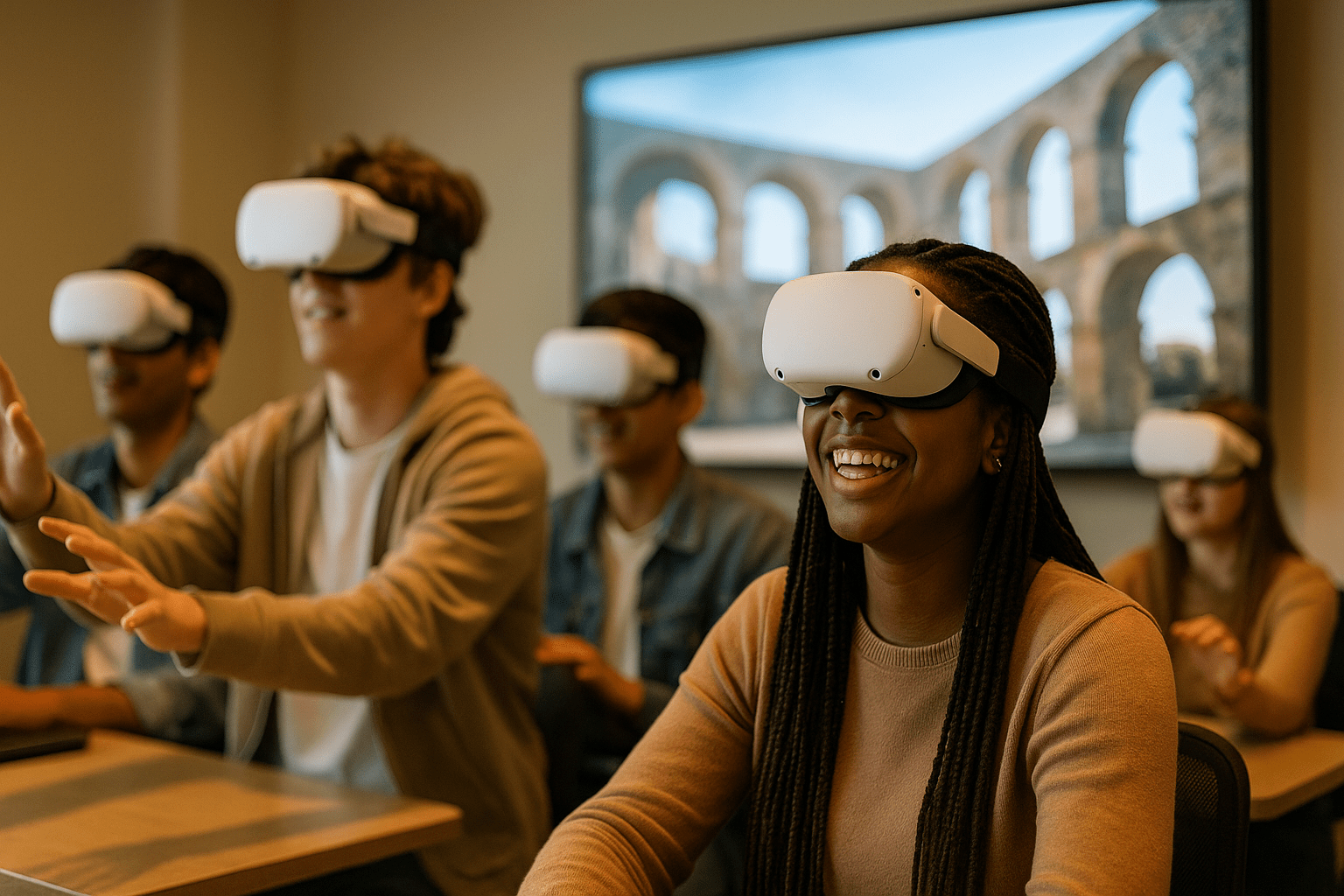Virtual Reality in Education Is Changing How We Learn
Virtual reality in education isn’t just a buzzword-it’s a powerful shift in how we think about learning environments. From immersive science labs to virtual field trips across ancient civilizations, VR is carving out serious space in modern classrooms and training centres. And it’s not just the tech-savvy institutions jumping aboard-the tools are becoming more accessible, and the benefits harder to ignore.
So, why does this matter now? Because student engagement is lower than ever, traditional methods are struggling to keep pace with a changing world, and digital-native learners expect more than one-dimensional content. If you’re curious how VR can actually improve student learning-and worried about whether it fits your infrastructure-you’re not alone. Let’s unpack where the real educational impact of VR lies. And no, it doesn’t require wearing a VR headset all day (though if it did, at least those headsets look pretty cool).
VR in Education Has Grown Up
Long gone are the bulky, glitchy prototypes of the early days. Today’s VR technologies offer plug-and-play setups, dynamic instructional content, and measurable results. VR in education isn’t reserved for tech universities anymore-it’s being used in primary school classrooms and vocational training centres alike. As educational institutions increasingly embrace these advancements, they are also aligning with emerging learning management system trends 2025 that prioritize immersive experiences. These trends focus on integrating VR with traditional curricula to enhance engagement and retention. With tools that analyze student performance in real-time, educators can tailor lessons to better meet individual needs, making learning more effective and enjoyable.
What makes this possible?
- Affordable VR headsets: Devices like Meta Quest and Pico make it easier for schools to experiment without deep investment.
- Cloud-based platforms: Easily stream VR lessons without complex software installations.
- Educational partnerships: Many institutions now co-develop content with VR vendors to suit specific learning goals.
Diving into VR Training in the Education Sector
When thinking about virtual reality learning, training applications come up again and again. Whether it’s simulated surgical procedures or practice courtrooms for law students, VR provides high-stakes environments with zero real-world risk. And it builds muscle memory–something textbooks can’t offer.
The Immersive Experience
Let me give you an example. Imagine you’re learning about Roman architecture. Traditionally, that might mean reading a paragraph or looking at a diagram. Now imagine using virtual reality to walk through the Colosseum, peek into rooms, inspect ancient construction, and hear guided narration. That multisensory, immersive experience? It sticks.
That’s exactly what the best VR experiences do-they anchor new concepts through interaction. Instead of memorising terms, students live the subject matter. This hands-on, immersive modality is one key reason why VR improves retention significantly across disciplines.
When is it worth using VR over traditional methods?
- When a process is dangerous, costly, or time-consuming in real life
- When spatial understanding matters (think mechanical systems or anatomy)
- When learners benefit from active participation rather than passive listening
Also, when someone’s too afraid to do public speaking-they can practice in a virtual auditorium. Virtual courage? Absolutely counts.
The Role of Virtual and Augmented Reality in Education Settings
Let’s clear something up: augmented reality and virtual reality aren’t mutually exclusive. In fact, many classrooms blend both for a complete reality learning model. Picture students assembling virtual machines using AR overlays on real-world parts and then testing the assembled products in a fully virtual environment. That kind of blended, hands-on learning is what separates a functional VR setup from a flashy gimmick.
Common applications in education include:
- Interactive science experiments using virtual environments
- Language labs with avatar interactions
- Historical simulations that walk students through key events
- Soft skills training in customer service, sales, or HR
You might not expect this, but literature classes can benefit too-letting students explore settings of novels in 3D VR environments creates emotional resonance and context that traditional text simply can’t match.
How Educators Are Using Virtual Field Trips Without Leaving the Classroom
One of the simplest-and most loved-uses of virtual reality in education is the virtual field trip. Whether it’s a rainforest in Borneo, a coral reef off the coast of Australia, or the rings of Saturn, students can visit these places in VR with their classmates in real time.
And here’s the thing: they’re not passive observers. These trips often feature interactive content, choose-your-path structures, and embedded quizzes. Students explore at their own pace and emerge better storytellers and critical thinkers as a result.
Common Pitfalls When Using VR in Education (And How to Avoid Them)
Here’s the tricky part-VR can fall flat if not implemented with intention. Some common mistakes include over-reliance on flashy graphics, underestimating technical infrastructure needs, or assuming students will figure everything out intuitively. Spoiler: they won’t.
Here’s how to get it right:
- Assess students’ baseline tech skills first. Provide onboarding where needed.
- Ensure Wi-Fi and device specs can handle VR technologies without lag or interruption.
- Tie every VR session to measurable learning objectives-not just “explore this cool 3D model.”
Also, make sure there’s a backup plan. Remember, even the best virtual reality applications still rely on real-world infrastructure.
Why Infrastructure Planning Is Critical for Virtual Reality Implementation
Don’t overlook this: you need servers, storage, content licenses, proper lighting (for camera-based systems), low-latency WiFi, and charging stations. And we haven’t even touched on classroom seating configurations or hygiene protocols for shared VR headsets.
Infrastructure affects everything-so it’s crucial to include IT teams, curriculum designers, and educators early in the planning phase. No one wants to unbox 30 headsets only to find zero USB-C ports. (We’ve seen it.)
How Virtual Reality Improves Student Retention Rates
The impact of VR on student retention is well-documented. Neuroscience backs up what teachers know from experience: people remember what they do, not what they’re told. And VR provides a safe space to do things again and again-from lab skills to language fluency.
VR taps into active learning, multisensory engagement, and gamification-all methods already proven to boost retention. But now they’re rolled into one powerful tool.
Examples of improved learning outcomes:
- Medical trainees demonstrate greater retention when using VR simulations over traditional lectures
- Language learners show faster fluency when immersing in culturally situated virtual environments
- Engineering students build stronger diagnostic skills by troubleshooting virtual machinery regularly across scenarios
Use Cases Across Different Learning Environments
One of the best ways to understand the role of VR in student learning is to examine real-world case studies. Diverse institutions are already using it. Here’s how:
- Higher Education: Architecture and design students walk through scale models before ever lifting a pencil.
- Vocational Training: Trainee electricians simulate complex wiring routes without live wires.
- Corporate Upskilling: Businesses use virtual reality to rehearse leadership scenarios or client pitch rooms.
Each context makes use of the same base technology-VR headsets with specialised content-but in radically different ways. The flexibility is what makes it powerful.
Let’s Talk Content: What VR Technologies are Actually Used in Education
Not all VR platforms are created equal. Some offer open-source frameworks. Others rely on proprietary hardware ecosystems. It’s important to choose VR tools that integrate well with your LMS (especially if you’re running on Moodle™ software).
Key VR technologies and platforms used in education include:
| Platform | Strengths | Integration |
|---|---|---|
| Unimersiv | Rich historical and science content | Standalone with exportable reports |
| ClassVR | Designed specifically for schools | Can integrate via LTI to LMSs like Moodle™ software |
| ENGAGE | Session recording and live event features | Robust LMS integration tools |
Tip: Make sure your content licensing matches your intended use case. Many educators stumble here.
FAQs About Virtual Reality in Education
How is virtual reality used in education?
Virtual reality is used in education to create immersive, interactive simulations that help students engage with content more deeply. This includes virtual labs for science, historical recreations, and virtual field trips, as well as skill-based training such as surgical simulations or language immersion environments.
What is the main benefit of using VR in teaching and learning?
The main benefit is enhanced engagement and retention. VR encourages active learning by allowing students to experience rather than just observe. This significantly improves memory retention, problem-solving abilities, and motivation.
What is the role of virtual reality in enhancing students’ learning?
VR enhances learning by making abstract concepts tangible and allowing repetition and practice in a risk-free environment. It supports different learning styles, offers real-time feedback, and can create empathy by immersing students in different perspectives or situations.
What is the virtual reality method of teaching?
The VR method of teaching involves using virtual environments to supplement or replace traditional instruction. Lessons are designed to include interactive simulations, scenario-based learning, and visual/spatial content delivery that aligns with specific curriculum goals.
Want to Bring Virtual Reality into Your Classrooms?
Whether you’re delivering training content on vocational skills or exploring virtual reality in education across general subjects, the key is strategic implementation. At Pukunui, we work closely with educational institutions to enhance their Moodle™ software platforms with VR integrations, ensuring teachers have the tools and support they need.
Contact us to talk about how you can implement VR into your courses effectively-and affordably. We offer consultations, demos, and integration support tailored to your curriculum and infrastructure.
Don’t just teach. Let them experience.

